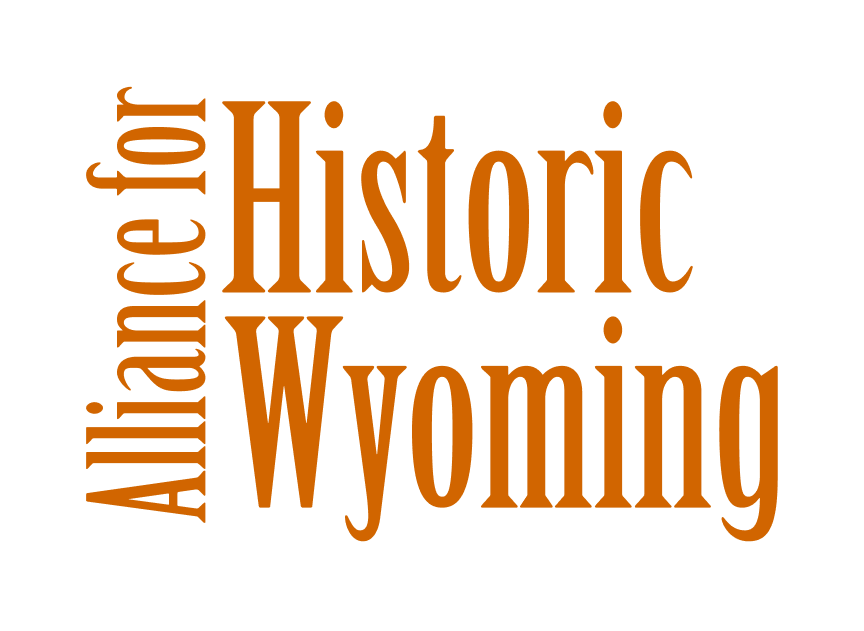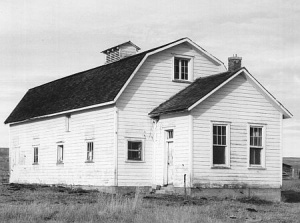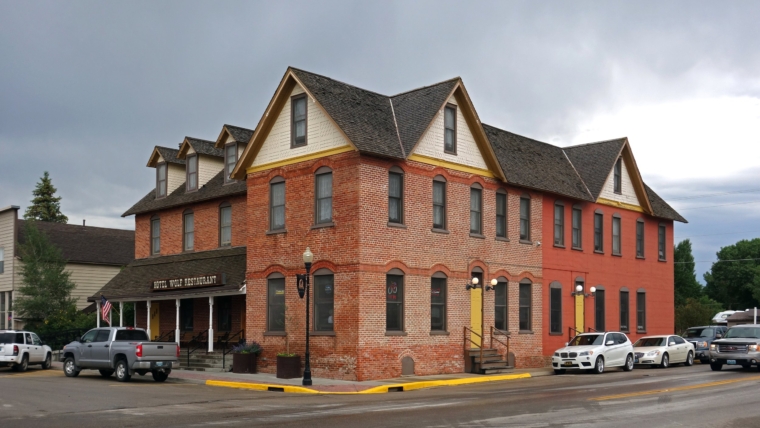By Megan Briggs
July 20, 2016
The site of early U.S. military post Fort McKinney is located two miles west of Buffalo, Wyoming in Johnson County. A sign on U.S. Highway 16 marks the entrance to the site of the fort. The fort wasn’t originally here – it was moved in 1877 due to a lack of supplies at the previous location. The fort was named to commemorate Lt. J. A. McKinney who was killed in battle with the Cheyenne on the Red Fork of the Powder River in 1876. At the height of operations, Fort McKinney housed seven companies of soldiers and consisted of about 14 buildings, including officer quarters, barracks, stables, warehouses, and a hospital. Several of the original structures still remain on the site and have been re-purposed for different uses.
 The original hospital building at Fort McKinney has been converted into an office building.
The original hospital building at Fort McKinney has been converted into an office building.
During the 1880s, Fort McKinney housed at least four companies of Buffalo Soldiers, all members of the Black Ninth Cavalry, making it a significant site in Western African American history. At the time, as many as twenty-five thousand Black soldiers served in the four African American regiments of the U.S. military. Unlike White units, which were moved between the frontiers and more urban areas, all four Black regiments were solely located in the West up until the Spanish-American War in 1898. This decision made by the War Department was meant to avoid racial violence Black soldiers would most likely face in the southern and eastern states. In forts similar to Fort McKinney during the 1880’s, Black officers and enlisted men would bring their wives and children to live with them. In most cases, the wives would work as laundresses or servants to the officers residing in the forts.
The main duties for soldiers at Fort McKinney were to keep the Plains Native American groups from causing disputes between each other and the military. Along with intervening in Native American affairs in the area, the soldiers protected a section of the Union Pacific Railway called the Rock Creek Stage Line. This railway ran from Rock Creek, close to present day Rock River, Wyoming, up into the southern part of the Montana Territory and carried mail and passengers through the region.
Black troops in the Ninth Cavalry stationed at Fort McKinney were most widely known for their involvement in the Johnson County War. Cattle rustling was the central issue of this dispute. In 1884, the state declared that all unbranded cattle could be claimed by the Wyoming Stockgrowers Association, which represented the state’s major stockgrowers, even though the cattle were already owned by settlers with small- scale holdings. Angered by the unfair law, rustlers disrupted the major stockgrowers’ attempts to collect the cattle given to them by the law. In April of 1892, in response to the rustlers’ actions, around 50 men led by Stockgrowers Association member Frank Wolcott traveled to KC Ranch where they expected to find and kill fourteen of the supposed rustlers. They succeeded in killings two of the rustlers, then retreated to TA Ranch about thirteen miles south of Buffalo, Wyoming.
White soldiers from the Sixth U.S. Calvary were called out from Fort McKinney into the area to defuse the situation. They surrounded the “invaders” as they would later be called and brought them into custody to stand trial in Cheyenne. However, this did not ease tensions in the region. In June of 1892 the Buffalo Soldiers of the Ninth U.S. Calvary were called into the area from Fort McKinney. Assuming they were allies of the invading stockgrowers, the ranchers and rustlers were further angered by the presence of the Buffalo Soldiers, and the Ninth Cavalry was bombarded with racial violence and aggression during their stay. With their efforts doing little to soothe the heightened tensions in the area, the Buffalo Soldiers were given military orders to vacate and return to the neighboring fort. The experiences of the Ninth Calvary during this time reflect similar realities that Buffalo Soldiers faced in the West.
Fort McKinney was disbanded in 1894. Since 1903, The Veterans’ Home of Wyoming has resided on the land the fort used to occupy. Though the majority of the buildings within the fort were dismantled, two of the structures still remain. One of the original buildings has been transformed into a garage, while the original hospital building has been repurposed into a state office building. Although the fort no longer exists in its entirety, it still stands as an important historic site for the Black Western experience.

The Fort McKinney Historic District was listed on the National Register of Historic Places in 1976.
Sources:
Schubert, Frank N. “The Suggs Affray: The Black Cavalry in the Johnson Country War”. Western Historical Quarterly, Vol. 4 No. 1. Utah State University. January, 1973. 57-68.
Taylor, Quintard. In Search of the Racial Frontier: African Americans in the American West. Illustrated, revised. W.W. Norton, 1999. 164- 184.
http://www.wyohistory.org/encyclopedia/fort-mckinney
http://www.wyohistory.org/essays/johnson-county-war
Contemporary images taken by Megan Briggs
Historical image from National Register of Historic Places:
http://wyoshpo.state.wy.us/NationalRegister/Site.aspx?ID=200
LIKE WHAT YOU JUST READ?
- Browse our archive of Historic Places and Spaces Profiles by clicking here.
- To learn about all of our campaigns and initiatives, click here.
- Subscribe to our newsletter to learn more about what’s going on in Wyoming.
- Donate or become a member to help us produce stories, organize events, and be a voice for preservation across the state.
- Like us on Facebook, and follow us on Twitter and Instagram to see our latest updates!





1 Comment
byDoc Settles
My dear friends Schubert & Taylor both great authors on Wyoming Buffalo Soldiers history.. Doc Settles, founder Wy Buffalo Soldiers Monument
Comments are closed.